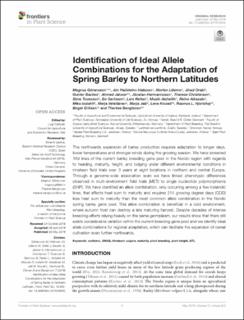| dc.contributor.author | Göransson, Magnus | |
| dc.contributor.author | Hallsson, Jón Hallsteinn | |
| dc.contributor.author | Lillemo, Morten | |
| dc.contributor.author | Orabi, Jihad | |
| dc.contributor.author | Backes, Gunter | |
| dc.contributor.author | Jahoor, Ahmed | |
| dc.contributor.author | Hermannsson, Jonatan | |
| dc.contributor.author | Christerson, Therese | |
| dc.contributor.author | Tuvesson, Stine | |
| dc.contributor.author | Gertsson, Bo | |
| dc.contributor.author | Reitan, Lars | |
| dc.contributor.author | Alsheikh, Muath K | |
| dc.contributor.author | Aikasalo, Reino | |
| dc.contributor.author | Isolahti, Mika | |
| dc.contributor.author | Vetelainen, Merja | |
| dc.contributor.author | Jalli, Marja | |
| dc.contributor.author | Krusell, Lene | |
| dc.contributor.author | Hjortshøj, Rasmus | |
| dc.contributor.author | Eriksen, Birger | |
| dc.contributor.author | Bengtsson, Therese | |
| dc.date.accessioned | 2020-11-02T06:18:53Z | |
| dc.date.available | 2020-11-02T06:18:53Z | |
| dc.date.created | 2019-11-29T13:00:56Z | |
| dc.date.issued | 2019 | |
| dc.identifier.issn | 1664-462X | |
| dc.identifier.uri | https://hdl.handle.net/11250/2685953 | |
| dc.description.abstract | The northwards expansion of barley production requires adaptation to longer days,
lower temperatures and stronger winds during the growing season. We have screened
169 lines of the current barley breeding gene pool in the Nordic region with regards
to heading, maturity, height, and lodging under different environmental conditions in
nineteen field trials over 3 years at eight locations in northern and central Europe.
Through a genome-wide association scan we have linked phenotypic differences
observed in multi-environment field trials (MET) to single nucleotide polymorphisms
(SNP). We have identified an allele combination, only occurring among a few Icelandic
lines, that affects heat sum to maturity and requires 214 growing degree days (GDD)
less heat sum to maturity than the most common allele combination in the Nordic
spring barley gene pool. This allele combination is beneficial in a cold environment,
where autumn frost can destroy a late maturing harvest. Despite decades of intense
breeding efforts relying heavily on the same germplasm, our results show that there still
exists considerable variation within the current breeding gene pool and we identify ideal
allele combinations for regional adaptation, which can facilitate the expansion of cereal
cultivation even further northwards. | en_US |
| dc.language.iso | eng | en_US |
| dc.rights | Navngivelse 4.0 Internasjonal | * |
| dc.rights.uri | http://creativecommons.org/licenses/by/4.0/deed.no | * |
| dc.title | Identification of ideal allele combinations for the adaptation of spring barley to Northern latitudes | en_US |
| dc.type | Peer reviewed | en_US |
| dc.type | Journal article | en_US |
| dc.description.version | publishedVersion | en_US |
| dc.source.volume | 10 | en_US |
| dc.source.journal | Frontiers in Plant Science | en_US |
| dc.identifier.doi | 10.3389/fpls.2019.00542 | |
| dc.identifier.cristin | 1754530 | |
| dc.relation.project | Nordisk ministerråd: PPP_02 | en_US |
| cristin.unitcode | 192,10,2,0 | |
| cristin.unitname | Institutt for plantevitenskap | |
| cristin.ispublished | true | |
| cristin.fulltext | original | |
| cristin.qualitycode | 2 | |

